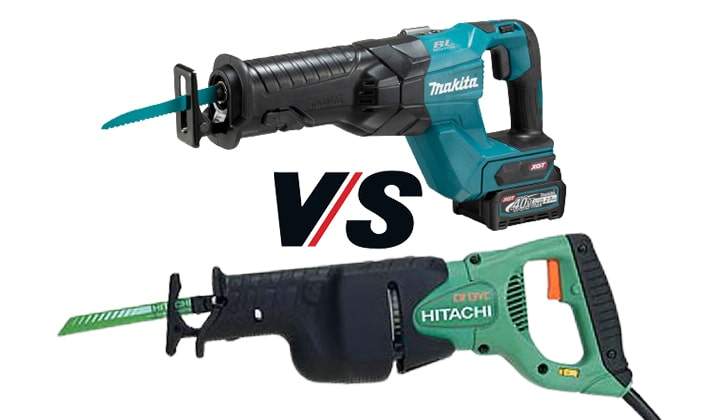Among many tools which have been used to build and construct, saws are within the most popular ones. The usage of a saw is varied, depending on the type of task you need it for.
Saws are often used in carpentry, wood works or at different construction sites for a number of jobs to be carried out.
One of the most popular questions is picking between a sabre saw and a reciprocating saw. While both might seem similar, they have some key traits that differentiate them. When looking at sabre saw and reciprocating saw, factors like motor capacity, strain of work and others are where they show their differences.
Sabre Saw vs Reciprocating Saw
Let’s take a closer look and find out which of these is the right saw for you.
Size Scale
Sabre saw and reciprocating saw differences start with the scale of work they are being used for. A sabre saw has a relatively smaller motor hence it is used for small scaled tasks and more fine work.
On the other hand, a reciprocating saw can be used to carry out large scale work such as cutting bigger and heavier materials. Judging by this, if your workload does not require large-scale cutting, the sabre saw is the way to go. The reciprocating saw is also available nonetheless, however it’s preferred for heavy-duty tasks as mentioned above.
Durability
A major difference between a sabre and reciprocating saw can also be highlighted when you compare the durability of both the saws. It is indeed a fact that a reciprocating saw is much more durable than a sabre saw.
The reason behind this is a heavy duty motor and a range of blades which are strong and sturdy. The motor of the Sabre saw and the light amount of pressure it can take makes it relatively less durable. Judging by this, if you’re in the market for a durable tool – the reciprocating saw is the way to go.
Nature Of Work
A Sabre saw is used for detailed cutting and fine work. It can be used to cut both wood and different metals. But a reciprocating saw is able to cut the thicker and tougher versions of wood and metals with a larger and more sturdy blade.
In order to reach spaces which aren’t easily accessible, the blade of a reciprocating saw can be turned at 90 degrees. The way a sabre saw can cut circular curves makes it way different from how a reciprocating saw works since that is a two hand operational saw. If your work requires extensive details, go with the sabre saw. Otherwise, reciprocating saw has you mostly covered
Blade
A reciprocating saw can work with blades which are able to be bent in situations where it’s required to do so. The blade can be bent parallel to cut through the object when the machine is at a certain angle. However, with a sabre saw achieving this task might not be possible since another tool would be needed.
A sabre saw is best utilised to cut different materials altogether. The blade of a sabre saw is toot headed and is often needed to cut much softer materials as compared to the blades of a reciprocating saw. The different kind of blade being used in a sabre saw also impacts the maneuverability of the saw and decreases it drastically.
Brands
This factor mostly addresses the rise of the general confusion between both saws. Different companies and brands have marketed and introduced both, the sabre saw and reciprocating saws differently.
Some brands state that they were the first ones to introduce and manufacture a reciprocating saw. The confusion between the differences is encountered at this point since they have named the power saws differently.
Learn: Give Your Window Blinds Style and Practicality
What is a Sabre Saw?
Precisely, a sabre saw is a jigsaw which is portable and moves up and down in a reciprocating motion as well which is why the confusion is caused between both the saws. However, a sabre saw has a stroke of about 1 inch.
It can make more fine angled cuts. It can also be used to rip and crosscut different materials such as metal and wood.
What is a Reciprocating Saw?
A reciprocating saw is quite self explanatory when it comes to the movement motion of the saw. Moreover, it is a kind of saw which is used when different demolition tools such as hammers fail to conduct the job.
Check more about the tools on this blog. When an old fitting or fixture has to be taken out and it becomes extremely time consuming. A reciprocating saw can make the task less time consuming.
It can also be used with a number of different blades and quick slices can be made through something even as strong as a concrete wall.
Learn: Reasons Why Your Home Needs a Redecoration
Conclusion: Which one should you choose?
In a nutshell, it all comes down to deciding on the best kind of saw for your desired tasks. Both the sabre saw and reciprocating saws have their own advantages and disadvantages. If you are someone who carries out heavy duty jobs using the saw, buying a reciprocating saw is the best decision you can possibly make.
On the contrary, if you need a saw which can be used to make fine cuts and incredible amount of detailing and if your tasks are not as tedious, a sabre saw would be ideal. The durability is also one of the major differences you should be considering and paying attention towards.
While making the right decision for yourself, you might not be looking for a saw which helps you make finer cuts but the size of its motor and pressure it can handle.
In the end, everything boils down to the nature and work-load of your task. Either way, both the sabre saw and the reciprocating saw are fine pieces of machinery.
Few Hand Picked articles for you
Lights for your Home
Furniture Restoration
Kitchen Layouts
Kitchen ideas
Wall Art Ideas
Carpet Cleaning Tips
Home redecoration
Areas to use ceramic tiles
Living room interior design ideas
Designer Bathroom Accessories


